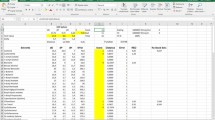Abstract
The influence of the thickness of silica gel layer on the penetration rate of selected liquids and, in consequence, on the value of surface free energy components determined by thin layer wicking method was studied. Plates of the following gel thickness were used: 0.25, 0.5, 1.0 and 2.0 mm. Measurements of the penetration rate of apolar liquids, i.e. three alkanes: octane, nonane and decane, diiodomethane, α-bromonaphthalene and two polar liquids: water and formamide were made for this purpose. From the obtained relationships x2=f(t) the suitability of Washburn’s equation in the whole penetration range (9 cm) was confirmed for all thicknesses of porous layers. However, the penetration rate of probe liquids changed with the thickness of the deposited layer, it was mainly dependent on an effective (apparent) radius of the interparticle pores. Using these results and the appropriate form of Washburn’s equation surface free energy components of silica gel 60 (for four thicknesses of layer) were calculated. It was found that values of apolar Lifshitz–van der Waals (γLWs=41.7±0.9 mJ m-2) and polar acid–base (γABs=11.5±0.5 mJ m-2): electron donor (γ-s=50.8±0.9 mJ m-2) and electron acceptor (γ+s≡0.7±0.1 mJ m-2) components of surface free energy were very similar for different layer thicknesses. Even in the case of a 2 mm thick layer reproducible values of both Lifshitz–van der Waals and acid–base component were obtained. It is important when the thin layers are prepared in laboratory conditions, i.e. from suspensions by water evaporating, and the deposited layer is of less controlled thickness. When diiodomethane and α-bromonaphthalene are considered as weakly polar liquids, the value of Lifshitz–van der Waals component of silica gel is very close to γLWs determined from n-alkanes.
Similar content being viewed by others
References
K. K. Unger, “Porous silica” (Amsterdam, Elsevier, 1979).
R. Leboda, Wiad. Chem. 30 (1976) 677.
L. C. Sander and S. A. Wise, CRC Crit. Rev. Anal. Chem. 13 (1987) 299.
J. Nawrocki and B. Buszewski, J. Chromatogr. 449 (1988) 1.
J. Nawrocki, Chromatographia 31 (1991) 177, 193.
R. K. Iler, “The chemistry of silica, solubility, polymeryzation, colloid and surface properties and biochemistry” (New York, Wiley-Interscience, 1979).
L. T. Zhuravlew, Colloids and surfaces 74 (1993) 71.
B. Buszewski, M. Jaroniec, P. Staszczuk and R. K. Gilpin, Yiad. Chem. 49 (1995) 223.
W. Kisielew, “Powierchnostnyje jawlenija w polprowodnikach i dielektrykach” (Nauka, Moskwa, 1970).
M. L. Hair and W. Hertl, J. Phys. Chem. 73 (1969) 4269.
G. Curthoys, V. Ya. Davydow, A. V. Kiselew, S. A. Kiselew and B. V. Kuznetsov, J. Colloid Interface Sci. 48 (1974) 58.
V. Gutman, “The donor–acceptor approch to molecular interaction” (New York, London, Plenum Press 1978).
C. H. Rochester and A. Strachan, J. Colloid Interface Sci. 177 (1996) 456.
E. Borello, A. Zecchina and C. Morterra, J. Phys. Chem. 71 (1967) 2938, 2945.
C. Clark-Monks and B. Ellis, J. Colloid Interface Sci. 44 (1973) 37.
F. Boccuzzi, S. colucciA, G. Ghiotti, C. Morterna and A. Zecchina, J. Phys. Chem. 82 (1978) 1298.
P. Fink and B. Camara, Z. Chem. 12 (1972) 35.
H. Knözinger and W. StÄhlin, Prog. Colloid and Polymer Sci. 67 (1980) 33.
C. J. van Oss and R. J. Good, J. Dispersion Sci.Technol. 9(4) (1988) 355.
C. J. van Oss, M. K. Chaudhury and R. J. Good, Separation Sci. Technol. 24(1 & 2) (1989) 15.
C. J. van Oss and R. J. Good, J. Macromol. Chem. A26(8) (1989) 1183.
C. J. van Oss, R. J. Good and H. J. Busscher, J. Dispersion Sci. Technol. 11(1) (1990) 75.
R. J. Good, N. R. Srivata, M. Islam, H. T. L. Huang and C. J. van Oss, In “Acid-Base Interactions” edited by K. L. Mittal and H. R. Anderson, Jr (VSP, Utrecht, 1991).
C. J. van Oss, Colloids Surfaces A: Physicochem. Eng. Aspects 78 (1993) 1.
C. J. van Oss, W. Wu, R. F. Giese and J. O. Naim, Colloids Surfaces B: Biointerfaces 4 (1995) 185.
R. J. Good and C. J. van Oss, In Modern approachs to wettability” edited by M. E. Schrader and G. Loeb (Plenum, New York, 1992).
R. F. Giese, P. M. Constanzo and C. J. van Oss, J. Phys. Chem. Miner 17 (1991) 611.
E. Chibowski and L. HoŁysz, Langmuir 8 (1992) 710.
L. HoŁysz and E. Chibowski, ibid. 8 (1992) 717.
E. Chibowski and F. Gonzalez-Caballero, ibid. 9 (1993) 1069.
L. HoŁysz, Polish. J. Chem. 68 (1994) 2699.
E. Chibowski and L. HoŁysz, J. Colloid Interface Sci. 164 (1994) 245.
E. Chibowski and L. HoŁysz, J. Mater. Sci. Technol. in press.
B. JaŃczuk and E. Chibowski, J. Colloid Interface Sci. 95 (1983) 268.
Cpravochnik khimika, Izd. Khim. Lit., Moscow, 1962 (in Russian).
“Physicochemical handbook” (WNT, Warsaw, 1974) (in Polish).
T. D. Blake and J. M. Haynes, J. Colloid Interface Sci. 30 (1969) 421.
J. Rayss, A. Gorgol, W. PodkoŚcielny, J. Widomski and M. ChoŁyk, J. Adhesion Sci.Technol. in press.
B. JaŃczuk and A. Zdziennicka, J. Mater. Sci. 29 (1994) 3559.
N. B. Hanay, “Chemia ciała stałego” (Warsow, PWN, 1972) (in Polish).
F. M. Fowkes, J. Colloid Interface Sci. 28 (1968) 493.
W. Drost-Hansen, Ind. Eng. Chem. 61 (1969) 10.
P. Staszczuk, B. JaŃczuk and E. Chibowski, Mater. Chem. Phys. 12 (1985) 469.
B. JaŃczuk, E. Chibowski and T. BiaŁopiotrowicz, Chem. Papers 40 (1986) 349.
L. J. M. Schlangen, L. K. Koopal, M. A. Cohen Stuart and J. Lyklema, Colloids Surfaces: Physicochemical and Engineering Aspects 89 (1994) 157.
I. D. Mikheikin, I. A. Abronin, G. M. Zhidorow and V. B. Kazansky, Kinet. Katal. 18 (1977) 1580.
A. Skapski, R. Billups and A. Rooney, J. Chem. Phys. 26 (1957) 1350.
M. Brun, A. Lallemand, J.-F. Quinson and CH. Eyraud, Thermochimica Acta 21 (1977) 59.
Author information
Authors and Affiliations
Rights and permissions
About this article
Cite this article
HOłYSZ, L. Surface free energy components of silica gel determined by the thin layer wicking method for different layer thicknesses of gel. Journal of Materials Science 33, 445–452 (1998). https://doi.org/10.1023/A:1004340301387
Issue Date:
DOI: https://doi.org/10.1023/A:1004340301387




